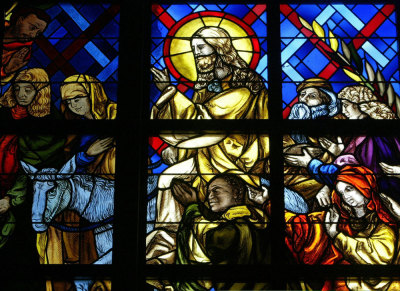Transgression is passé

One of the hallmarks of the modern age has been the death of the sacred. Nietzsche’s Madman understood that this was one of the central consequences of the death of God. But he, unlike the polite atheists he berated in the town square, knew that this was both an exhilarating and a terrifying matter: Now human beings would themselves have to rise to be gods, to create their own systems of value, their own sacred rites, their own meaning of life.
This was never going to be either easy or stable. Nor has it ultimately led human beings to transcend themselves and ascend to some higher, übermenschlich plane. Today we witness merely the desecration of all that was once held to be sacred. Our culture remains trapped by the sacred idioms of the past and doomed to the constant and increasingly conformist transgression of old boundaries.
Take, for example, the latest “art” promoted by the European Union: A series of photographs, currently on display at the European Parliament building, taken by lesbian artist Elisabeth Ohlson. The images depict, among other things, scenes of Jesus surrounded by gay men dressed in leather bondage gear. Now, if Jesus were alive today He would certainly be speaking to such people, as He spoke to prostitutes and tax collectors in first-century Palestine. But Ohlson claims that her work represents Christ “loving LGBT rights.” Whether all gay people like to see themselves caricatured in bondage gear might itself be an interesting question to ask. The left’s favored word “fetishization” came to my mind as I looked at the pictures. What is not interesting, however, is the artwork itself.
The display represents both the bankruptcy of modern culture and its inability to offer anything even approximating a positive vision for humanity. For generations now the artistic establishment has been in thrall to the notion of transgression. But transgression is only significant if there is something — some rule, some custom, something sacred — to transgress. Without such, transgression itself rapidly degenerates into a series of empty gestures that tend to become both more extreme and more vacuous at the same time. Art then ceases to be about embodying and transmitting cultural value and is instead a momentary iconoclastic performance that parasitically and paradoxically depends upon resurrecting icons that have long since fallen. Only because there is a folk memory of religion does the general public have some notion that these banal photographs are meant to be shocking. And only to the increasingly marginal numbers of actual Christians are they truly so.
Such derision of Christianity is now decidedly passé. It is nearly 40 years since Serrano’s Piss Christ and Scorsese’s Last Temptation of Christ. The mockery of Christianity is today as clichéd and predictable as the lighting in a Thomas Kinkade painting. Nor does it “speak truth to power.” Rather, it merely offers smug affirmation of the triumph of one of the most powerful lobby groups within Western culture. If you doubt that, imagine what the reaction would be if someone asked to display the text of Romans 1 on the walls of the parliament building. It would soon become apparent who truly holds the levers of cultural power. Indeed, we do not need to display a biblical text to prove this. It is ironically confirmed by the fact that Ohlson herself had a previous piece of art “canceled” because it was not inclusive enough for the powerbrokers of this present age.
Nietzsche noted it takes a long time for societies to grasp the significance of the death of God. But we are surely at that point now. Our artistic class makes that very clear, and so it is time to put these artists in the dock: We get it. You hate Christianity and the Western cultures that it informed. You despise the sexual ethics that it represents. You mock the vision of humanity that it holds forth. That all you can do is resurrect religious imagery merely to knock it down again, or have someone vomit on you as part of entertainment aimed at teenagers, indicates that you actually have nothing to say at all. Those of us who lived through the punk rock era have seen it all before. So what do you now offer as a positive vision of that with which you wish to replace Christianity?
Philip Rieff coined the term deathwork to refer to those works of art that waged war on a culture by using the idioms of the sacred in order to destroy the sacred. It is tempting to accuse the E.U. of promoting just such deathwork in this exhibition of our contemporary world’s sexual fetishes. But that would be to flatter both the artist and the art. This is not a deathwork, for what it mocks is already dead. Rather, it is emblematic of the vacuum that has replaced Western culture. Such art says nothing new because it is part of a culture that has nothing to say. All it can do is rehash the images of a religious past and flatter itself that in doing so it is tearing down an oppressive power structure.
At the end of a Pink News report on the E.U. display, readers are asked how they “feel” about the article, an appropriate question in a therapeutic world. “Pity” is not an option given, but would seem the only fitting response to those so easily satisfied with a culture of unremitting nothingness.
Originally published at First Things.
Carl R. Trueman is a professor of biblical and religious studies at Grove City College. He is an esteemed church historian and previously served as the William E. Simon Fellow in Religion and Public Life at Princeton University. Trueman has authored or edited more than a dozen books, including The Rise and Triumpth of the Modern Self, The Creedal Imperative, Luther on the Christian Life, and Histories and Fallacies.




















